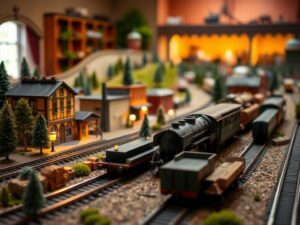How to Create Realistic Track Plans for HO Scale Layouts
How to Create Realistic Track Plans for HO Scale Layouts
How to Create Realistic Track Plans for HO Scale Layouts
Welcome, fellow train enthusiasts! So you’re ready to embark on the exciting journey of creating your own HO scale model railroad layout? Fantastic! The world of miniature trains is brimming with endless possibilities for creativity and imagination. But before you grab those tools and start laying track, let’s dive into the essential foundation â designing realistic and captivating HO scale track plans.
For beginners, this might seem like a daunting task. Don’t worry; we’ll break it down step-by-step, providing both fundamental guidance and advanced tips to help you build your dream layout.
Understanding the Basics of HO Scale Track Plans
First, let’s get familiar with the core elements that define a track plan:
- Gauge: This refers to the distance between the rails, and for HO scale, it’s 16.5 mm (approximately 0.65 inches). Most manufacturers adhere to this standard, making compatibility a breeze.
-
Track Types: HO scale offers various track types:
- Straight Track: Simple sections of track for connecting curves and allowing trains to run in a straight line.
-
Curves: Introduce graceful transitions, adding realism and visual interest to your layout. Tracks come in different radius sizes â the smaller the radius, the tighter the curve.
- Turnouts (Switch): Allow trains to switch between tracks, enabling access to different sections of your layout and facilitating switching operations.
-
Switches: The mechanism controlling the turnout; these come in hand-thrown or electric varieties for different levels of automation.
-
Layout Type: Consider which layout type best suits your space and desired operations:
- Continuous Run Layout: Tracks continuously loop around, allowing trains to run endlessly without needing a start/stop point.
-
Modular Layout: Consists of individual modules (track sections) that can be interconnected and rearranged for greater flexibility.
Getting Started: Sketching Your Dream Track Plan
Before you pick up a soldering iron, take some time to sketch your ideas on paper. Think about:
-
Scale: The most common scale for HO is 1:87, meaning 1 inch represents 87 inches (or approximately 7 feet) in real life.
-
Space: How much area do you have dedicated to your layout?
-
Terrain: Do you envision rolling hills, flat plains, or a combination of both?
-
Scenery: Will there be buildings, bridges, roads, and forests integrated into the design?
Step-by-Step Guide to Creating an HO Scale Track Plan
Now that we have the groundwork covered, let’s turn those sketches into a tangible plan:
1. Define Your Objectives:
What do you want your layout to achieve? Realistic operations? Visual appeal? Specific prototypes or era recreations? Knowing your goals will guide your track design decisions.
2. Space Considerations:
Measure your layout area accurately and sketch its boundaries on a large sheet of paper (or use computer drafting software).
3. Basic Track Placement: Start with the perimeter tracks to define the overall shape of your layout. Will it be an oval, rectangle, or a more complex freeform design?
4. Curves and Radius Selection: Experiment with different curve sizes to achieve smooth transitions while maintaining operational functionality. Keep in mind, sharper curves may limit train lengths.
5. Incorporating Turnouts: Strategically place turnouts to connect separate sections of track, allowing trains to switch between lines, create sidings (spur tracks for parking), and simulate realistic operations.
6. Station or Operating Zones: Identify the areas where trains will load, unload, and exchange cars. Consider the length of platforms required for passenger service and design dedicated tracks for staging freight trains.
7. Additional Track Elements: Explore options like passing sidings (tracks that allow trains to pass each other) for increased operational realism and loops or spurs (dead-end tracks) to accommodate longer train consist.
Pro Tips for Crafting Realistic HO Scale Track Plans:
- prototypical Inspiration: Research actual railroad layouts for inspiration, paying attention to curves, switch positions, yard structures, and overall track organization. There are plenty of online resources dedicated to showcasing prototype plans!
-
Variable Gauge Transition Curves: For smoother operation when joining sections of different radii, incorporate gradual transition curves.
- Realistic Track Layering: Consider simulating ground features like ditches, embankments, or tunnels using elevation changes and creative track arrangements.
-
Utilize a Flexible Layout Program (optional): Computer programs like AnyRail, SCARM, and PlanPlus allow you to experiment with track plans digitally, offering 3D views and even testing train movements!
Don’t Forget: Your HO Scale Track Plans Are Just the Beginning!
Once your plan is finalized, you can embark on the exciting process of assembling, painting, weathering, and bringing your miniature railroad world to life!
Remember, creating an HO scale track plan is a journey filled with creativity and discovery. Donât hesitate to experiment, learn from others in our community, and have fun!
If you have any questions about creating realistic HO scale track plans, please don’t hesitate to ask â weâre here to help each other build amazing layouts!




